Sure you may be telling yourself, boiled chicken and rice what’s the big deal and I wouldn’t blame you for doing so. I was invited by my Korean friend and her brother to join them for a traditional Korean dish called dak baek suk or 누룽지 닭 백숙 in Korean.
I wasn’t certain what to expect: I knew it was a whole chicken being served with rice but that was about the extent of my knowledge. The restaurant we went to was called 장수촌 (translates to “long life village”) and is located about twenty minutes drive from the town of Pyeongtaek. I don’t think they get many westerners in the place as when we entered everyone looked at us while we waited for a table.
It was around 1:30 in the afternoon on a Sunday and the place was absolutely full. Although it seems counter intuitive to most westerners (to me at the very least) they tend to eat this dish on warm summer days as it’s suppose to help refresh your “vitality” or “stamina”.
The place was filled with Korean families and we definitely stood out being the one westerner with a Korean brother and sister. We sat down and my Korean friends took care of the ordering.
We started off by ordering a plate of cold soba noodles that were mixed in with what I suspect was gochujang paste (Red pepper paste) along with pieces of lettuce, cabbage and cucumbers. The cold noodles and crunchy lettuce in a spicy marinade was very refreshing. It’s served on a large ceramic plate and looks like an oversize salad when it arrives. We had eaten most of the dish and decided to place the remaining amounts into small bowls in order to make room for the soon to arrive main meal!
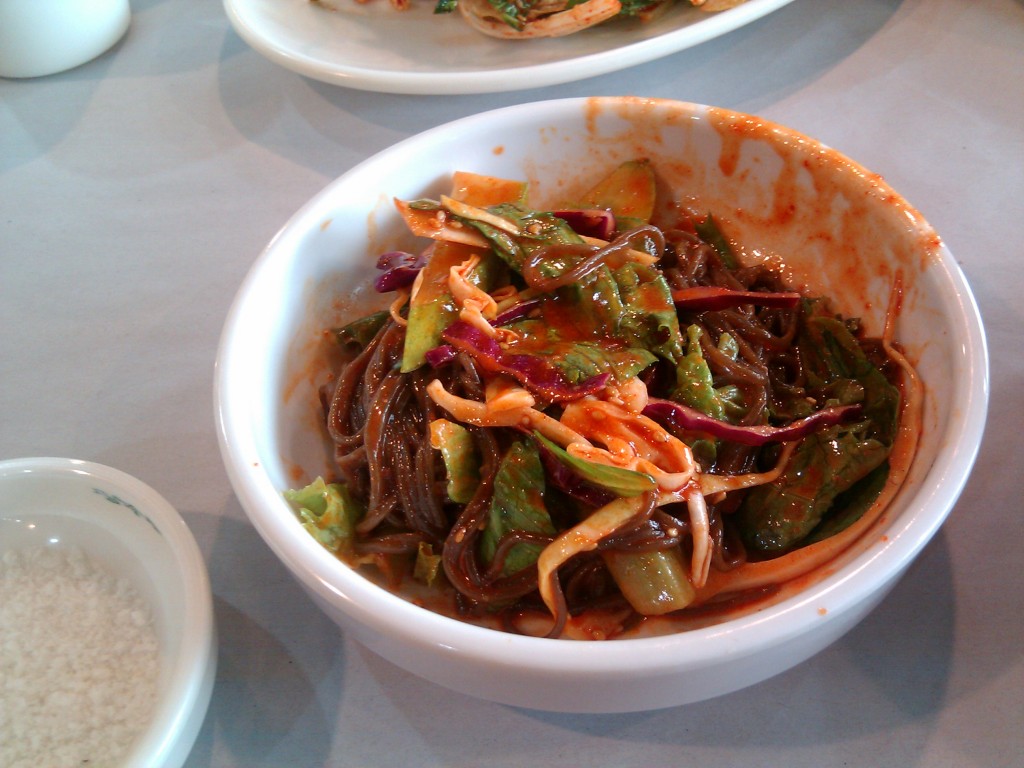
Included in the side dishes was a small bowl of peppers which were quite mild to the taste. When dipped into the 쌈장 (ssamjang) were very delicious!
The cabbage in a cold water based soup was spicy (possibly from the whole pepper in the soup). My Korean friend explained it was a type of “White Kimchi” or as they call it in Korean 백김치. It was interesting to bite into the cold cabbage yet still get a sense of warmth from the spiciness.
You can also see the typical radish Kimchi (uncut). Using the Korean scissors I cut up a few pieces just to give it a try. Like with most Kimchi the taste varies greatly on depending on the local recipe. You can see all of the mentioned side dishes here:
It wasn’t long after we had finished the cold soba noodles that the main dish 누룽지 닭 백숙 (dak-baek-suk) arrived. In the pictures below we had already started picking the chicken apart but when it arrives it’s a whole chicken in the same ceramic bowl as you see it in these pictures. Inside the chicken is a mix of mostly rice with a few dates and pieces of garlic and ginseng mixed in for added taste.
The chicken was moist and tender and the rice had formed a porridge like substance or congee as the Asian countries call it. It’s extremely filling. At first I felt like the rice included with the chicken simply wouldn’t be enough for all three of us. It was with this thought in mind that I was surprised to see another ceramic bowl arrive full of rice with a brown crisp coating on the top. My Korean friend quickly explained that this was ‘all rice’. It once again had some small pieces of garlic and ginseng for added taste. I was delighted to see a large bowl of congee arrive at the table and we all quickly proceeded to fill our individual bowls with the steamy rice porridge. I thought the brown coating on top was actually chicken skin and was a little worried about the fat content but when I asked exactly what it was my Korean friend looked at me as If I had asked a silly question. She answered “rice that has turned crispy” and I then explained why I had asked the question ;-)
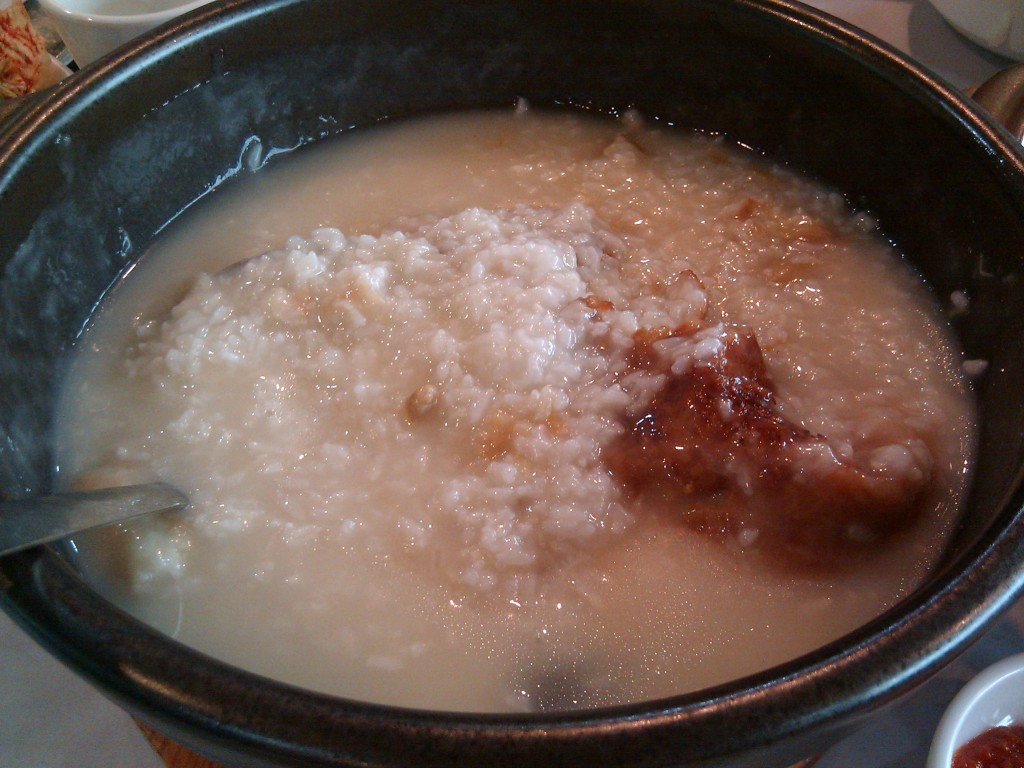
You may have noticed in some of the pictures small bowls with a white powdery substance in them. This was some “shaved” salt. The rice that had been stuffed in the chicken as well as the rice in it’s own bowl needed some seasoning. The salt (and as I later discovered from another table pepper) is mixed into your individual bowl according to how much salt or pepper you personally like.
The three of us were unable to finish eating the dish. The restaurant kindly provided paper containers in order for us to bring the leftovers with us. We threw them in the freezer and ate the leftovers the following weekend. Like with many soups it tasted almost as good if not better once it had been reheated. The rice porridge and chicken absolutely sticks to your stomach leaving with you a feeling of being full for hours.
Here’s how I would rate this dish: Since I first tried it I’ve thought about having it again almost on a daily basis. I explained to my Korean friend that even if we were only the two of us we should go have the dish again and bring the left overs home with us…. really delicious!
The cost for the meal was 32 000 won, approximately (32 Canadian). That works out to being a little under 12$ per person. For a feast of this size it’s really worth it!
I can easily see myself making this dish during our cold winter season in Canada. It’ll be a real treat to pull one of these prepared meals out of the freezer after coming in from one of our cold Canadian nights. I leave you with a picture of my own little bowl of Dakbaeksuk after I had mixed in some congee, salt and chicken!
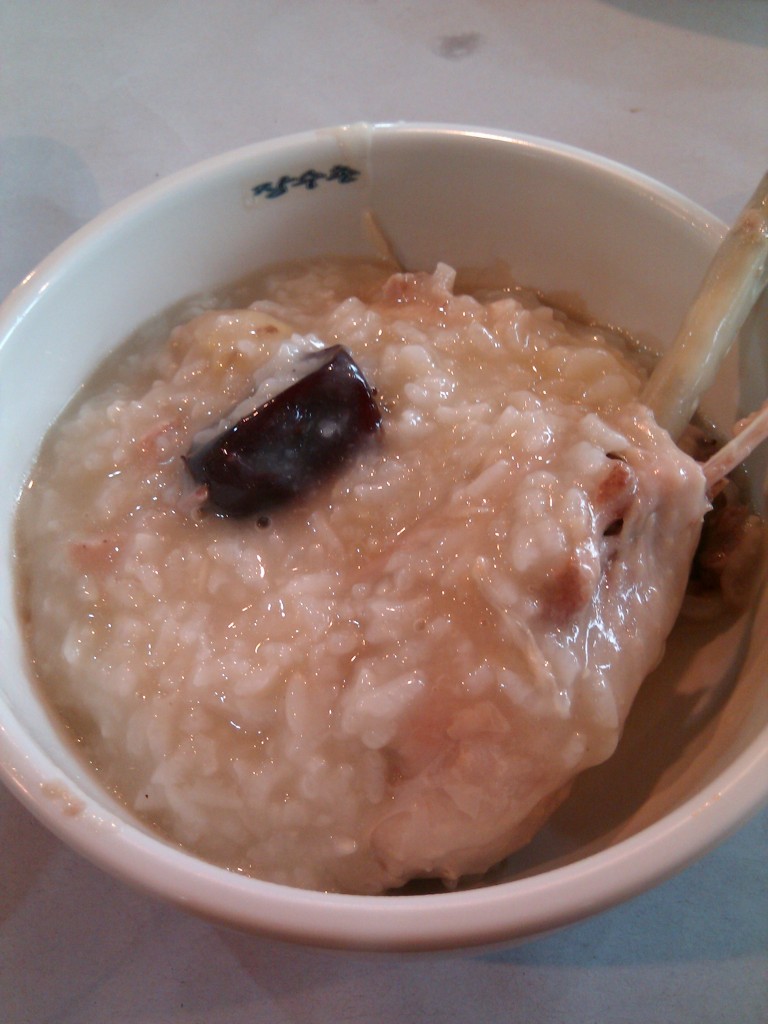

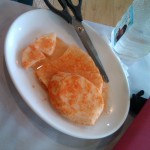
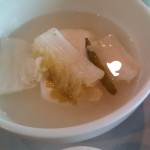

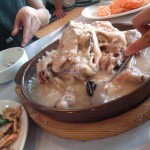
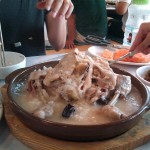
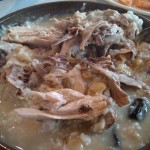
3 Responses to Dak-baek-suk 누룽지 닭 백숙 (boiled chicken and rice) in Pyeongtaek South Korea